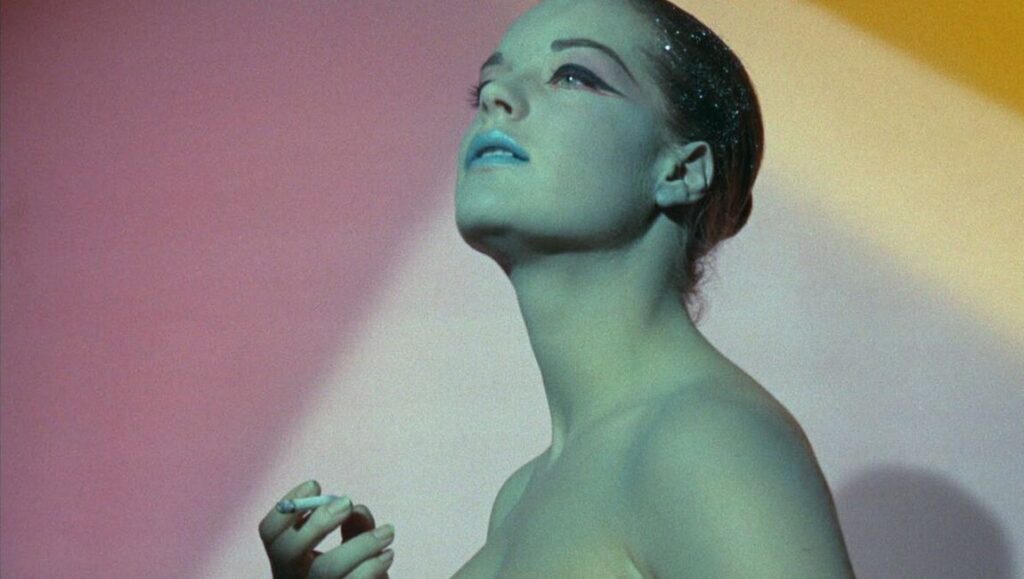Although the story of Henri-Georges Clouzot’s L’Enfer began over 45 years ago, the short history of this documentary was launched in a Paris elevator, where director Serge Bromberg was stuck for two hours with the widow of the celebrated French director. Their conversation easily drifted to Clouzot’s films but eventually landed on his one true regret, the unfinished L’Enfer (aka Inferno or Hell) and the 185 cans of unused film sitting dormant. This incredible moment of serendipity is laid out in the prologue of Henri-Georges Clouzot’s Inferno, but what isn’t mentioned is the light bulb that must have been glowing in the film archivist’s head within the close quarters of that elevator. The compulsory comment, one that Bromberg must have uttered as delicately as possible during the conversation, is almost palpable: “I would love to take a look at those reels of film.” Fortunately, there must have been something in Bromberg that Inès de Gonzalez trusted; she allowed him and co-director Ruxandra Medrea full access to the footage of what could have been Clouzot’s greatest success but turned into his greatest failure. Inferno unveils a revelatory patchwork of Clouzot’s swoon-worthy footage that will have you wishing you could turn back the hands of time and alter the film’s cruel fate.
Inferno is a balancing act of discovering unseen hours of film and giving it some context. Built from interviews with the crew, the documentary dissects a production fueled and doomed by obsession. In 1964, L’Enfer was the highly anticipated follow-up to La Vérité by a director sometimes referred to as the French Hitchcock. Even before the first clapperboard was snapped, L’Enfer was expected to be Clouzot’s best yet, even by his own assessment. About a man consumed by jealousy, this relatively large production received an “unlimited budget” from Columbia executives who had seen just a few screen tests. Assembling a star cast, with Romy Schneider and Serge Reggiani in the leads, as well as a talented crew, L’Enfer contained possibilities that no one but Clouzot seemed to understand. Obsessed with manipulating sound and image that would fit the mood of his madness, Clouzot plagued his crew with changes and rewrites that sent many people packing, including Reggiani. Just as it seemed that the film had been pushed to the brink and beyond, Clouzot suffered a heart attack and, on doctor’s orders, L’Enfer came to an abrupt and portentous halt.
What remains are hours of footage that are so incredibly seductive on a visual and emotional level that it’s astounding and heartbreaking that nothing ever came of it. Much of what we see in Inferno are the artful screen tests with Schneider, the images of which will haunt dreams for an eternity. Clouzot’s camera seems to have taken on the same obsessive quality towards Schneider as her fictional husband would have in the film, with no end to Schneider’s alluring face as the hypnotic focal point. With much of the soundtrack lost, Bromberg and Medrea try to build a well-rounded portrait of L’Enfer by staging portions of the script. But these digressions feel like having to eat your vegetables before you can have your cake. There is an analytical draw to the interviews with the production crew and to the analysis of Clouzot’s meticulous storyboards and preparations, but it doesn’t compare to the visceral pull of the film that Clouzot had in mind. Even the straightforward black and white takes of Reggiani’s character contain the subtle, mysterious aura of this ill-fated film. Unfortunately, the three people who truly could have added another dimension to the documentary — Clouzot, Reggiani and Schneider — have all passed away, leaving an undeniable gap in our understanding of both Clouzot and his project.
Signs of brilliance within the chaos are there, but they are painfully unsubstantiated. Imagine watching Hearts of Darkness if Apocalypse Now had never been finished: this is the sum of Henri-Georges Clouzot’s Inferno. You get the feeling that Clouzot, a dogged planner, set out to show those off-the-cuff New Wavers how to make a cutting-edge film, but his ambition and perhaps his ego completely did him in. After his heart attack, he worked for a few years in television earning enough money to finance his last film, 1968’s La Prisonnière, which incorporates many of the hallucinatory effects from L’Enfer with limited yet bizarre effect. Was this the film that Clouzot wanted to make in 1964? I don’t think so. But neither was Claude Chabrol’s half-hearted 1994 adaptation of the same name. Henri-Georges Clouzot’s Inferno is a fragmented tease open to endless speculation. Although Bromberg and Medrea have done a great service in bringing pieces of the unfinished film to an audience, their greatest achievement is pushing aside the idea that L’Enfer was a failure, immortalizing Clouzot’s creative zeal.


Comments are closed.